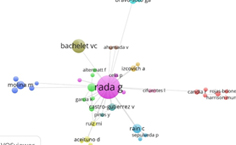| ||||||||||
martes, 19 de diciembre de 2017
Cuidado respiratorio perioperatorio del obeso / Perioperative respiratory care of obesity
Disectomia endoscopica por hernia de disco L5/S1 y discoplastia L4/L5
http://www.clinicadeartroscopia.com.mx/academia/disectomia-endoscopica-por-hernia-de-disco-l5-s1-y-discoplastia-l4-l5/
Disectomia endoscopica por hernia de disco L5/S1 y discoplastia L4/L5 Equipo de cirugía de Columna Findmed Spine Experts
¿Cuál es la política óptima para reducir la incidencia del alcohol en la siniestralidad vial?
http://www.traumaysiniestros.com.mx/siniestros/cual-es-la-politica-optima-para-reducir-la-incidencia-del-alcohol-en-la-siniestralidad-vial/
Record URL:http://dx.doi.org/10.1016/j.trf.2017.06.017
Record URL:http://www.sciencedirect.com/science/article/pii/S1369847816301838
Availability:
Find a library where document is available. Order URL: http://worldcat.org/issn/13698478
An assessment of the effects of alcohol consumption and prevention policies on traffic fatality rates in the enlarged EU. Time for zero alcohol tolerance?
Este artículo es originalmente publicado en:
Record URL:http://dx.doi.org/10.1016/j.trf.2017.06.017
Record URL:http://www.sciencedirect.com/science/article/pii/S1369847816301838
Availability:
Find a library where document is available. Order URL: http://worldcat.org/issn/13698478
DE:
- a
- Applied Economics & Management Research Group, University of Seville, Spain
- b
- Dept. of Economic Policy, University of Barcelona, Spain
https://doi.org/10.1016/j.trf.2017.06.017
Transportation Research Part F: Traffic Psychology and Behaviour
Volume 50, October 2017, Pages 38-49
Todos los derechos reservados para:
© 2017 Elsevier Ltd. All rights reserved.
Supplemental Notes:
Abstract reprinted with permission of Elsevier.
Este estudio mantiene que una reducción de la tasa de alcoholemia por sí sola no disminuiría la siniestralidad. Los resultados obtenidos permiten destacar el papel relevante que para la seguridad vial desempeñan la tolerancia social y los hábitos de consumo en torno al alcohol que caracterizan a los 28 estados miembros de la Unión Europea.
Keywords
Alcohol consumption,
Drink driving,
Control policies,
Zero tolerance, approach
Traffic fatalities,
European Union
Palabras clave
Consumo de alcohol, Beber mientras se maneja, políticas de control, tolerancia cero, enfoque fatalidades de tráfico
Consumo de alcohol, Beber mientras se maneja, políticas de control, tolerancia cero, enfoque fatalidades de tráfico
Analgesia obstétrica / Obstetric analgesia
| |||||||||||
Hábitos actuales de prescripción de dolor para operaciones comunes de hombro: una encuesta de la membresía de American Shoulder and Elbow Surgeons
http://www.mihombroycodo.com.mx/academia/habitos-actuales-de-prescripcion-de-dolor-para-operaciones-comunes-de-hombro-una-encuesta-de-la-membresia-de-american-shoulder-and-elbow-surgeons/
Fuente
Este artículo es publicado originalmente en:
https://www.ncbi.nlm.nih.gov/pubmed/29249547
http://www.jshoulderelbow.org/article/S1058-2746(17)30665-1/fulltext
De:
Welton KL1, Kraeutler MJ2, McCarty EC1, Vidal AF1, Bravman JT1.
J Shoulder Elbow Surg. 2017 Dec 14. pii: S1058-2746(17)30665-1. doi: 10.1016/j.jse.2017.10.005. [Epub ahead of print]
Todos los derechos reservados para:
Copyright © 2017 Journal of Shoulder and Elbow Surgery Board of Trustees. Published by Elsevier Inc. All rights reserved.
Abstract
BACKGROUND:
Orthopedic surgeons are among the highest prescribers of narcotic pills, and no guidelines currently exist for appropriate management of postoperative pain within this field. The purpose of this study was to gain understanding of the current pain management strategies used perioperatively and postoperatively among orthopedic shoulder surgeons.
CONCLUSION:
The majority of shoulder surgeons use a standard pain management protocol in perioperative and postoperative settings. Regimens frequently include a regional nerve block, nonsteroidal anti-inflammatory drugs, and short-acting oral narcotics. Findings from this study provide guidelines on standard pain management strategies for common shoulder operations based on expert opinion.
KEYWORDS:
Acute pain; opioid prescription; pain management; rotator cuff repair; shoulder stabilization; total shoulder arthroplasty
Resumen
ANTECEDENTES:
Los cirujanos ortopédicos se encuentran entre los principales prescriptores de las píldoras narcóticas, y actualmente no existen pautas para el tratamiento adecuado del dolor postoperatorio en este campo. El objetivo de este estudio fue comprender las estrategias actuales de tratamiento del dolor que se usan perioperatoriamente y posoperatoriamente en los cirujanos de hombro ortopédicos.
CONCLUSIÓN:
La mayoría de los cirujanos de hombro usan un protocolo estándar de manejo del dolor en situaciones perioperatorias y postoperatorias. Los regímenes con frecuencia incluyen un bloqueo nervioso regional, medicamentos antiinflamatorios no esteroideos y narcóticos orales de acción corta. Los hallazgos de este estudio proporcionan pautas sobre estrategias estándar de manejo del dolor para operaciones comunes de hombro basadas en la opinión de expertos.
Copyright © 2017 Journal of Shoulder and Elbow Surgery Board of Trustees. Publicado por Elsevier Inc. Todos los derechos reservados.
PALABRAS CLAVE:
Dolor agudo; prescripción de opioides; el manejo del dolor; reparación del manguito rotador; estabilización del hombro; artroplastia total del hombro
Copyright © 2017 Journal of Shoulder and Elbow Surgery Board of Trustees. Published by Elsevier Inc. All rights reserved.
PMID: 29249547 DOI: 10.1016/j.jse.2017.10.005
Current pain prescribing habits for common shoulderoperations: a survey of the American Shoulder and ElbowSurgeons membership
Fuente
Este artículo es publicado originalmente en:
https://www.ncbi.nlm.nih.gov/pubmed/29249547
http://www.jshoulderelbow.org/article/S1058-2746(17)30665-1/fulltext
De:
Welton KL1, Kraeutler MJ2, McCarty EC1, Vidal AF1, Bravman JT1.
J Shoulder Elbow Surg. 2017 Dec 14. pii: S1058-2746(17)30665-1. doi: 10.1016/j.jse.2017.10.005. [Epub ahead of print]
Todos los derechos reservados para:
Copyright © 2017 Journal of Shoulder and Elbow Surgery Board of Trustees. Published by Elsevier Inc. All rights reserved.
Abstract
BACKGROUND:
Orthopedic surgeons are among the highest prescribers of narcotic pills, and no guidelines currently exist for appropriate management of postoperative pain within this field. The purpose of this study was to gain understanding of the current pain management strategies used perioperatively and postoperatively among orthopedic shoulder surgeons.
CONCLUSION:
The majority of shoulder surgeons use a standard pain management protocol in perioperative and postoperative settings. Regimens frequently include a regional nerve block, nonsteroidal anti-inflammatory drugs, and short-acting oral narcotics. Findings from this study provide guidelines on standard pain management strategies for common shoulder operations based on expert opinion.
KEYWORDS:
Acute pain; opioid prescription; pain management; rotator cuff repair; shoulder stabilization; total shoulder arthroplasty
Resumen
ANTECEDENTES:
Los cirujanos ortopédicos se encuentran entre los principales prescriptores de las píldoras narcóticas, y actualmente no existen pautas para el tratamiento adecuado del dolor postoperatorio en este campo. El objetivo de este estudio fue comprender las estrategias actuales de tratamiento del dolor que se usan perioperatoriamente y posoperatoriamente en los cirujanos de hombro ortopédicos.
CONCLUSIÓN:
La mayoría de los cirujanos de hombro usan un protocolo estándar de manejo del dolor en situaciones perioperatorias y postoperatorias. Los regímenes con frecuencia incluyen un bloqueo nervioso regional, medicamentos antiinflamatorios no esteroideos y narcóticos orales de acción corta. Los hallazgos de este estudio proporcionan pautas sobre estrategias estándar de manejo del dolor para operaciones comunes de hombro basadas en la opinión de expertos.
Copyright © 2017 Journal of Shoulder and Elbow Surgery Board of Trustees. Publicado por Elsevier Inc. Todos los derechos reservados.
PALABRAS CLAVE:
Dolor agudo; prescripción de opioides; el manejo del dolor; reparación del manguito rotador; estabilización del hombro; artroplastia total del hombro
Copyright © 2017 Journal of Shoulder and Elbow Surgery Board of Trustees. Published by Elsevier Inc. All rights reserved.
PMID: 29249547 DOI: 10.1016/j.jse.2017.10.005
Un caso muy desafiante … / A very challenging case…
http://www.lesionesdeportivas.com.mx/academia/un-caso-muy-desafiante-a-very-challenging-case/
Un caso muy desafiante … un paciente masculino de 67 años. Cayó desde la copa de un árbol mientras trabajaba en el jardín. Sin lesión neurovascular. Húmero proximal complejo, Bankart ósea enorme (algunos dirían mejor llamarlo fractura glenoidea) y fractura de la punta coracoide. Decidimos tratarlo con una placa anatómica bloqueada, la eliminación del fragmento glenoideo y el procedimiento Latarjet (subcap clásico trans). Nos dijo que estaba listo para volver a la jardinería tan pronto como lo autoricemos.
A very challenging case… a 67 year old male patient. Fell from a treetop while gardening. No neurovascular injury. Complex proximal humerus, huge bony Bankart (some would argue to better call it a glenoid fracture) and coracoid tip fracture. We decided to treat it with an anatomic locked plate, removal of glenoid fragment and Latarjet procedure (classic trans subscap). He told us his ready to get back to gardening as soon as we authorize it.

viernes, 15 de diciembre de 2017
Medwave edición noviembre-diciembre 2017
| ||||||||||||||||||||||||||||||||
| ||||||||||||||||||||||||||||||||
|
Suscribirse a:
Entradas (Atom)











